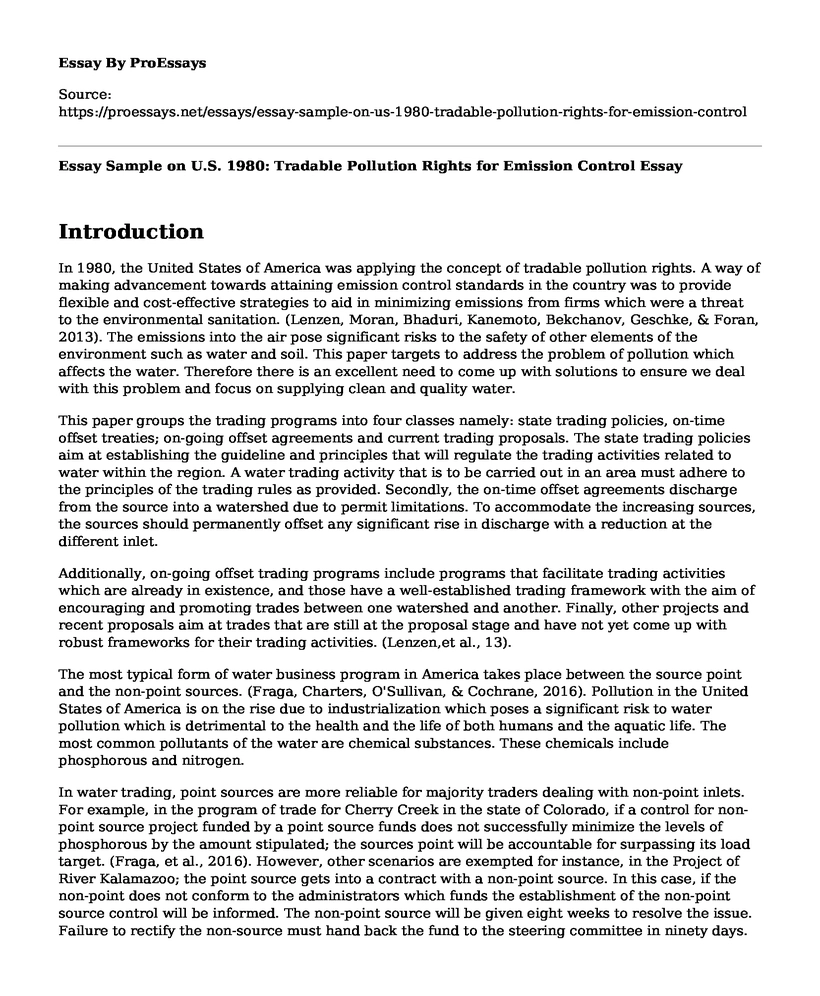Introduction
In 1980, the United States of America was applying the concept of tradable pollution rights. A way of making advancement towards attaining emission control standards in the country was to provide flexible and cost-effective strategies to aid in minimizing emissions from firms which were a threat to the environmental sanitation. (Lenzen, Moran, Bhaduri, Kanemoto, Bekchanov, Geschke, & Foran, 2013). The emissions into the air pose significant risks to the safety of other elements of the environment such as water and soil. This paper targets to address the problem of pollution which affects the water. Therefore there is an excellent need to come up with solutions to ensure we deal with this problem and focus on supplying clean and quality water.
This paper groups the trading programs into four classes namely: state trading policies, on-time offset treaties; on-going offset agreements and current trading proposals. The state trading policies aim at establishing the guideline and principles that will regulate the trading activities related to water within the region. A water trading activity that is to be carried out in an area must adhere to the principles of the trading rules as provided. Secondly, the on-time offset agreements discharge from the source into a watershed due to permit limitations. To accommodate the increasing sources, the sources should permanently offset any significant rise in discharge with a reduction at the different inlet.
Additionally, on-going offset trading programs include programs that facilitate trading activities which are already in existence, and those have a well-established trading framework with the aim of encouraging and promoting trades between one watershed and another. Finally, other projects and recent proposals aim at trades that are still at the proposal stage and have not yet come up with robust frameworks for their trading activities. (Lenzen,et al., 13).
The most typical form of water business program in America takes place between the source point and the non-point sources. (Fraga, Charters, O'Sullivan, & Cochrane, 2016). Pollution in the United States of America is on the rise due to industrialization which poses a significant risk to water pollution which is detrimental to the health and the life of both humans and the aquatic life. The most common pollutants of the water are chemical substances. These chemicals include phosphorous and nitrogen.
In water trading, point sources are more reliable for majority traders dealing with non-point inlets. For example, in the program of trade for Cherry Creek in the state of Colorado, if a control for non-point source project funded by a point source funds does not successfully minimize the levels of phosphorous by the amount stipulated; the sources point will be accountable for surpassing its load target. (Fraga, et al., 2016). However, other scenarios are exempted for instance, in the Project of River Kalamazoo; the point source gets into a contract with a non-point source. In this case, if the non-point does not conform to the administrators which funds the establishment of the non-point source control will be informed. The non-point source will be given eight weeks to resolve the issue. Failure to rectify the non-source must hand back the fund to the steering committee in ninety days. (Fraga, et al., 2016).In conclusion, there is a need to control emissions from industries that would pollute other elements of the environment and which are vital for life. (Fraga, et al., 2016). Managing phosphorous and nitrogen aspects from getting into contact with water sources will go a long way to ensure quality water supply to the citizens. Additionally, heavy metals are also pollutants which must be controlled not to contaminate the water. Overall quality water supply is a foundation to quality health of the people.
References
Fraga, I., Charters, F. J., O'Sullivan, A. D., & Cochrane, T. A. (2016). A novel modelling framework to prioritize estimation of non-point source pollution parameters for quantifying pollutant origin and discharge in urban catchments. Journal of environmental management, 167, 75-84.
Lenzen, M., Moran, D., Bhaduri, A., Kanemoto, K., Bekchanov, M., Geschke, A., & Foran, B. (2013). International trade of scarce water. Ecological Economics, 94, 78-85.
Cite this page
Essay Sample on U.S. 1980: Tradable Pollution Rights for Emission Control. (2023, Jan 02). Retrieved from https://proessays.net/essays/essay-sample-on-us-1980-tradable-pollution-rights-for-emission-control
If you are the original author of this essay and no longer wish to have it published on the ProEssays website, please click below to request its removal:
- Water and Water Quality Essay
- Contraband Law Essay Example
- Sustainability: Renewable Energy Essay Example
- The Significance of Flint Towards Environmental Injustice - Essay Sample
- Essay Sample on Zero Waste Management
- Essay Sample on Leonardo Dicaprio and Climate Change
- Essay Sample on Australian Waste Management: Challenges and Stakeholders







